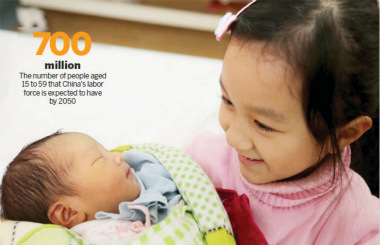Two-child policy to add 30m workers
Updated: 2016-01-15 07:43
By Shan Juan(China Daily Europe)
|
|||||||||||
|
Xue yaqing, 6, holds her brother on New Year's Day at No 1 Hospital in Xiangyang, Hubei province. The newborn is the second child of a couple from the city in Central China. [Photo / Xinhua] |
Scrapping one-child policy should help China ease challenges of an aging society
The scrapping of the one-child policy is expected to add more than 30 million people to China's working-age population by 2050, helping the nation avoid a looming labor shortage, a senior family planning official has said.
The number was revealed by Wang Pei'an, deputy director of the National Health and Family Planning Commission, at a news conference on Jan 11 held by the State Council Information Office.
The size of China's labor force aged 15 to 59, which has continued to dwindle since peaking at 940 million in 2012, is forecast to be 700 million in 2050, thanks to the two-child policy.
"There is an irreversible downward trend in the size of the working-age population, and the entire population, but the new two-child policy will help to slow the decrease," says Yuan Xin, an expert in population studies at Nankai University.
The Chinese government late last year announced it was scrapping its one-child policy, which had been in place since the late 1970s, on Jan 1, and the new policy came into force. Leaders are also discussing other policies, such as delaying the retirement age and improving the quality of human resources, to help sustain a high-efficiency labor force as it grows older.
According to Wang, the two-child policy also will help address challenges of the rapidly aging population. Without the policy, the number of people age 60 and older would make up 25.7 percent of the population by 2030. The policy is expected to lower that number by 2 percentage points.
In view of all this, "China still has a large enough labor force to sustain economic development", Yuan says.
At the news conference, Wang said, "The quality of the population, rather than the quantity, matters most in the current situation. We need to improve the quality of the entire population, particularly the workforce."
China's total fertility rate - the number of children an average woman gives birth to in her lifetime - is now 1.5. That is expected to peak by 2018 due to the relaxed family planning policy, with a population replacement level of 2 to 2.1, and then gradually decrease, Yuan says. The population would then be expected to drop, as the fertility rate would be below the replacement level.
According to scientists, China's population will begin to dwindle from a peak of 1.45 billion in about 2030. Without the two-child policy, Wang estimates that the peak year would come about two years earlier.
By 2050, the policy is expected to help add at least 150 million people, with a total population of 1.38 billion.
shanjuan@chinadaily.com.cn
(China Daily European Weekly 01/15/2016 page14)
Today's Top News
Chinese firms making inroads in UK
Value addition
IS claims Jakarta attack, targets Indonesia for 1st time
Chinese people most optimistic in global survey
COSCO offers 700m euros for Greece’s Piraeus Port
Istanbul bomber entered Turkey as refugee
Bird flu case confirmed in eastern Scotland
Cosco poised for Piraeus control
Hot Topics
Lunar probe , China growth forecasts, Emission rules get tougher, China seen through 'colored lens', International board,
Editor's Picks

|

|

|

|

|

|







